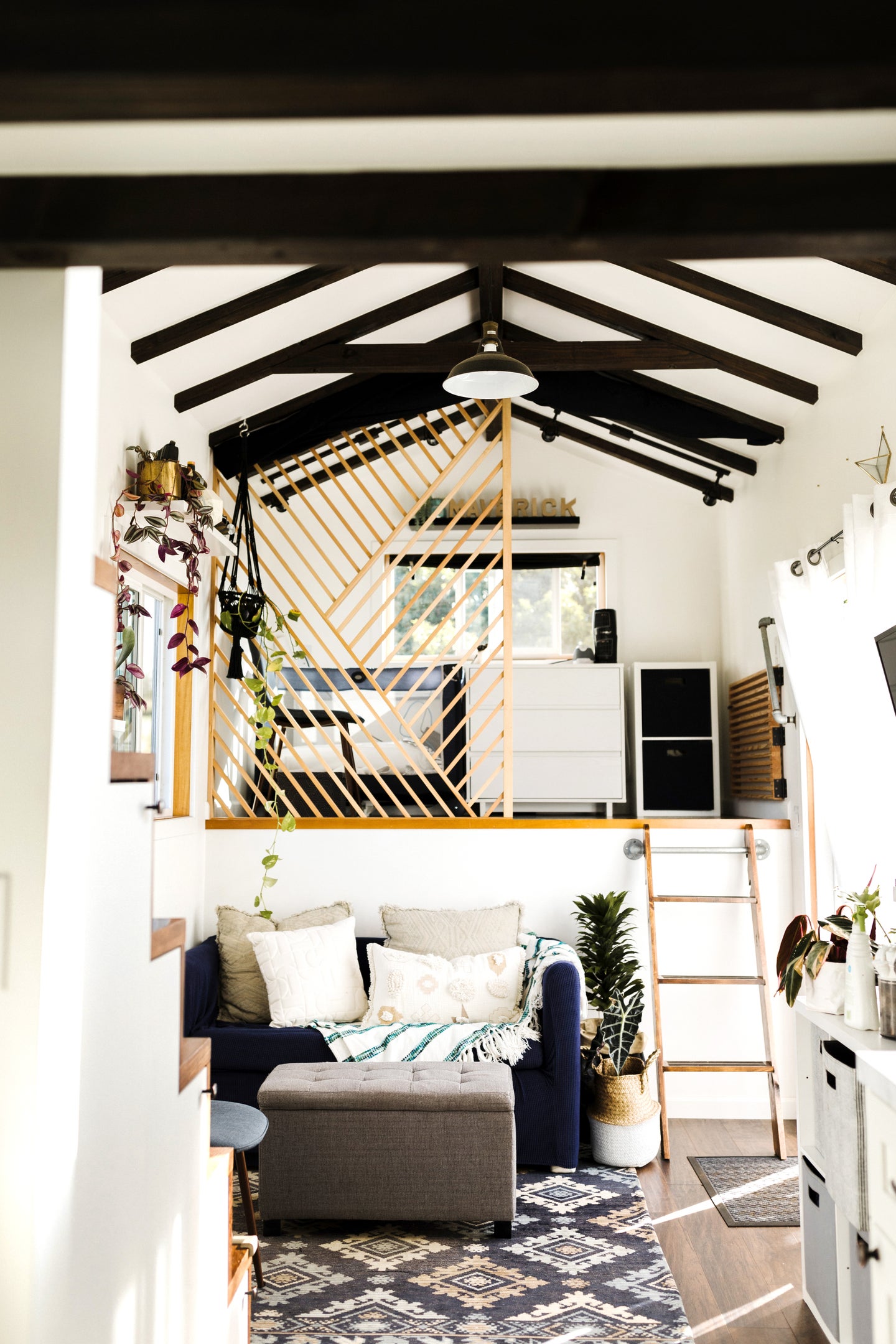How to Live in 360 Square Feet When You’re a Family of 3
Two moms tell all.
Updated Oct 11, 2018 9:51 PM
We may earn revenue from the products available on this page and participate in affiliate programs.
“Many aspects of having children can be difficult,” says Bela Fishbeyn. “But most don’t have to do with the size of your home.” That’s why she, her husband, Spencer Wright, and their toddler daughter, Escher, live happily in a tiny California home: 360 square feet, to be exact.
The prospect of small-scale living can be intimidating for many—or even seemingly impossible for some. Sure, when you’re living on your own or with a partner, the prospect of downsizing and keeping just the essentials can feel exciting. After all, there’s a reason why two out of five tiny home owners are over the age of 50 and why these houses have become such a compelling option for retirees. But when you’re just starting your family, there are other considerations at hand.
Toys, temper tantrums, and the need for alone time (especially for tired parents) can all add up to one big question: How do you actually manage to live in a tiny home when you have a little one on the loose?
Honestly: It doesn’t have to be that hard
When Zeena Fontanilla and her husband started constructing their 360-square-foot home in Maui, they didn’t anticipate expanding their family—but embraced the change heartily. “Our newest addition to the house, Maverick, who’s currently 1 1/2 years old, wasn’t included in the design process,” she says. “Three months into living in our tiny house I found out I was pregnant. We were ecstatic about the news! I think a lot of people were worried about how we would add a baby to our already-modest square footage, but I thrive on making small spaces functional.”
Throughout her pregnancy, Fontanilla planned how to accommodate her growing family, realizing that she actually didn’t have to make that many changes after all. “There are tons of baby-item fluff
on the market,” she says. By investing in things that grow with your child, you can be more sustainable and stay mindful of your space.
Loft space, too, can be optimized in unique ways, giving kids their own room to sleep and play. When designing her daughter’s room, Fishbeyn created an L-shaped loft rather than a traditional square shape. “Her twin bed has three walls surrounding her, with a curtain for lots of privacy. The L creates a natural play space in front of her bed and an easy, fun space to climb into from the ladder,” she says. “Throw a white noise machine up there and another floor-to-ceiling curtain between her room and the great room, and the rest of the home is ours to enjoy while she sleeps. We’ve had dinner parties down in the great room while she snoozes. It’s perfect.”
Cozy nooks make all the difference
Kids aren’t the only ones who need their own private spaces—that’s why both Fishbeyn and Fontanilla made a point, when designing their small homes, to create corners and crevices for themselves. “When most people design tiny homes, they tend to remove walls and maximize the square footage. We took it the other direction,” Fishbeyn says. “Our home uses a lot of soft and hard partitions to differentiate room to room, and we focused on maximizing perceptual space—how it actually feels to be in the house.”
Sometimes having your own place that’s out of sight of everyone else can end up making a big difference. “We transformed a little corner of our bedroom into a space just for me,” Fontanilla says of her home. “I love this spot because I can’t be seen from downstairs, where we spend the majority of our time. I love drinking coffee, dreaming, journaling, and thinking about new projects in this spot.” Even if you only have a bit of room for yourself, you can make the most of it.
The same holds true for bedrooms. While her daughter gets a loft, Fishbeyn and her husband get a full-on bedroom. Smart design, though, makes the small space feel not too small. “Our bedroom has shoji paper doors to close it off without creating a claustrophobic feel, and we have a liquid propane heater in the great room that puts off a little glow,” she says. “In the evenings, when we close the doors, there’s a faint light that comes through the shoji paper while we lie back and stargaze through a giant picture window. It’s dreamy and feels a bit like floating through the sky.” Let this be a lesson: Doors are, more often than not, a good call.
But close quarters can make you, well, closer
If you’ve lived with your partner in a smaller home or apartment, chances are, you’ll be able to manage living in a tiny home. And when you have kids, they might just reap some additional benefits. “We wanted a tight-knit family. Choosing a tiny home supported that lifestyle, and it’s worked well so far for us,” Fishbeyn says. “We all spend a lot of time together and practically never stop talking to one another. Escher is one of the more talkative kids I’ve ever met, and I’m sure a lot of that is just her personality, but it’s also hard for me to imagine that living in a tiny house hasn’t left its mark.” A small home not only makes family time happen all the time—it also guarantees more communication, which certainly has its advantages.
After all, when you’re communicating, you can solve disagreements just as easily as they arise—which makes many tiny home dwellers experts in conflict resolution. “My husband and I have always been extremely close and affectionate, so the close quarters didn’t bother us at all. We do all the same things—cook, clean, laundry, fight, cuddle—we did before, just in a lot smaller space,” Fontanilla says. “You definitely can’t hide from good or bad conversation in 360 square feet, which is the point, right?”
See more tiny homes: Well, This Is One Unexpected Benefit of Living in a Tiny Home So What’s It Really Like to Live in a Tiny Home? How One Tiny Home Designer Makes a Small Space Feel 10 Times Bigger





